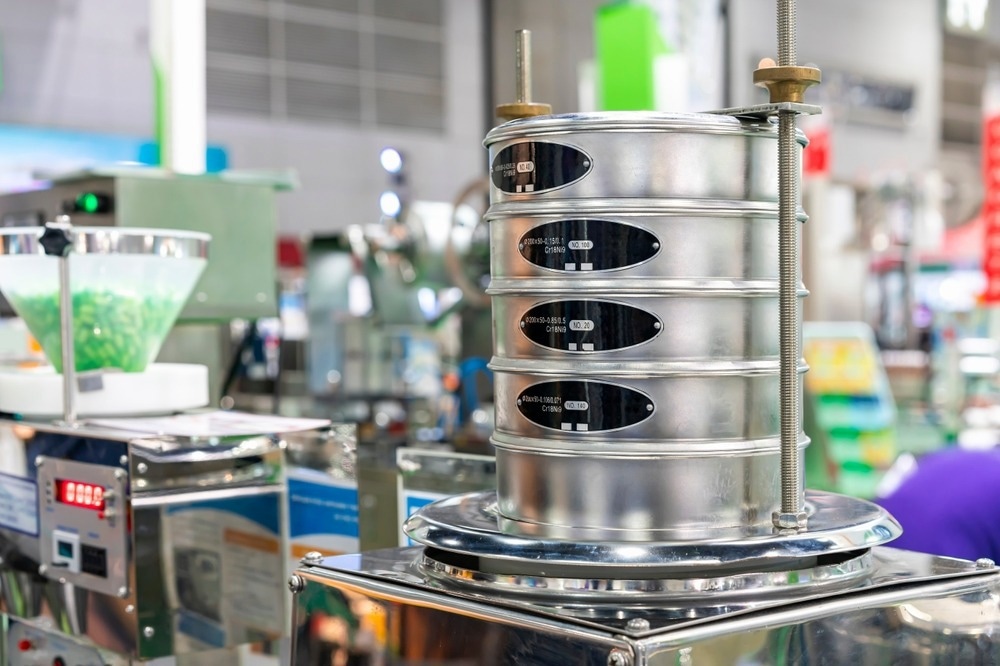Sieve shakers are extensively utilized in laboratories for research purposes as well as for various testing procedures. The article informs the readers regarding the basics and uses of sieve shakers to highlight their effectiveness and importance in the modern era.

Image Credit: Surasak_Photo/Shutterstock.com
What is a Sieve Shaker?
Sieve shakers are referred to as the specialized equipment that aids in molecular diffusion via a homogeneous layer of sieves, allowing for precise particle segregation.
Sieve shakers are utilized for segregation and size distribution measurement. To achieve total separation, a conventional sieve shaker passes granules through carefully interconnected layers with tracery filtration media while shaking the material. Sieving solid and liquid samples are possible depending on the apparatus.
Are there Different Types of Sieve Shakers Available?
There are several varieties of sieve shakers and laboratory analytical sieves that can efficiently be utilized for quality control and assessment laboratories for microscopic examination analysis or particle size measurement. The Sieve Analysis technique is referenced in the majority of ASTM, ISO, and other international standards.
Various sieve shakers that are utilized include gyratory sieve shakers, laboratory sieve shakers, rotatory sieve shakers, and electromagnetic sieve shakers.
What is the Difference Between Mechanical Models and Electromagnetic Sieve Shakers?
Mechanical sieve shakers use many dynamic elements to vibrate, knock, and furthermore disturb the sieve stack to assist particles in finding gaps in the mesh. While this equipment may not have the most cutting-edge innovation, they are reasonably simple to operate and are frequently represented in numerous regulatory requirements.
Electromagnetic sieve shakers are gadgets that use a novel 3-D elliptical movement to aid particulate migration throughout a layer of test sieves. Electromagnetic shakers are calmer throughout assessment than traditional sieve shakers since they do not have as many movable parts.
Construction of Laboratory Sieve Shakers
The Laboratory Sieve Shaker is made up of three parts: a platform for retaining the filter sieve layers, a power unit, and a foundation. The cradle is comprised of a surface that is attached to the bottom ends of two straight vertical load-bearing rods.
The upper-level extremities are equipped with suspension systems to offer longitudinal support that may swivel around its attachment. On the vertical supporting rods, a sieve clamp, gripping ring, and nuts are utilized to securely hold the top rod against the sieves.
Working Principle
Data on pore size variation, filter loading, sieving technique, particulate size, and shape are required to efficiently employ sieve shakers for filtering. Furthermore, the proportion of the sieve open area to the gross area must be addressed. Powder qualities such as workability and cohesiveness can have an impact on sieving.
Depending upon the method, the specimen is transported horizontally or vertically during sifting. During this action, the granules and filter are pushed around. A grain goes through the mesh sieve or remains on the sieve exterior based on particle diameter.
A particle's chance of flowing through the net holes is determined by parameters such as grain size, particle alignment, and the number of times the particles come into touch with the net apertures. As a result, filtering is impacted by sieving duration and sieve motion.
Advantages
These sieve shakers are user-friendly and easy for the users to effectively utilize for particle segregation. A major advantage is the less time required for the sieving procedure. The compact size of the equipment makes the installation very easy as well, and its low cost gives it a massive edge over other available techniques.
Are There any Limitations?
Dry sieving is less precise than wet sieving for particles smaller than 100 mm. Furthermore, the sieve study inferred that all granules are round (circular), which is not necessarily the case. Furthermore, an enlarged or flattened particulate cannot be successfully studied with a sieve.
This apparatus does not successfully separate particulates smaller than 50 mm. If the size is lowered further, errors may arise. Sieves can get clogged and deformed if not controlled and maintained appropriately. This could lead to massive maintenance costs.
Research Study
A study by Poullet et al. in the journal Water compares the hand segregation method with the mechanical sieving method utilizing sieves of various diameters. Onboard the dredger, specimens were retrieved from the tray of a lagging vacuum dredger and sieved manually with filters of 10 and 20 cm sizes.
The primary size metrics D50, standard deviation, kurtosis, and skewness exhibited discrepancies in the findings. Among the key findings, it should be mentioned that the tiny sieves approach yielded the greatest figures for D50 and kurtosis. The mechanical shaker approach in the experiment, on the other hand, yielded the lowest numbers.
Furthermore, the sieving process had no effect on standard deviation or skewness, implying that the particle distribution was altered, but the form stayed unchanged.
In short, the laboratory sieve shakers make it simple, quick, repeatable, and, most importantly, accurate to conduct analyses. However, more experimentation and research are needed to overcome the shortcomings.
More from AZoM: Different Sieving Methods for Varying Applications
References and Further Reading
Brown, R., 2021. What Is a Sieve Shaker? (Definition, Types, and Cost). [Online]
Available at: https://blog.wstyler.com/particle-analysis/what-is-a-sieve-shaker
Choudhary, A., 2022. Principles construction working uses merits demerits of sieve shaker cyclone separator. [Online]
Available at: https://www.pharmaguideline.com/2007/02/principles-construction-working-uses-merits-demerits-of-sieve-shaker-cyclone-separator.html
Gaurav, 2019. An Introductory Note on Laboratory Sieve Shakers. [Online]
Available at: https://www.authorbench.com/post/Laboratory-Sieve-Shaker
Poullet P. et. al. 2019. Influence of Different Sieving Methods on Estimation of Sand Size Parameters. Water. 11(5). 879. Available at: https://doi.org/10.3390/w1105087
Disclaimer: The views expressed here are those of the author expressed in their private capacity and do not necessarily represent the views of AZoM.com Limited T/A AZoNetwork the owner and operator of this website. This disclaimer forms part of the Terms and conditions of use of this website.